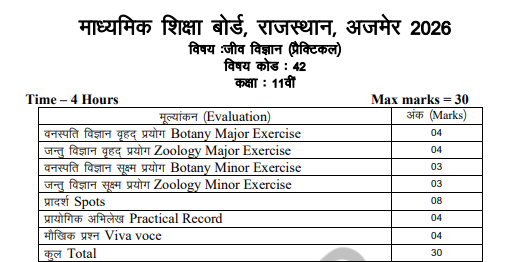RBSE Class 11 Biology Syllabus 2025-26: The Rajasthan Board, or RBSE, is the state board of India that administers the educational system of the state of Rajasthan. The board promotes bilingual education in Hindi and English. Therefore, RBSE’s syllabus can be downloaded in Hindi as well as English, depending on the medium of instruction. Students can download the revised RBSE Class 11 syllabus from the official website of RBSE or can check this article for an eloquent idea about their Rajasthan Board Class 11 Biology syllabus.
In the newly released RBSE Class 11 Biology syllabus, Check out the unit-wise course structure and detailed syllabus below. Download the RBSE Class 11 Biology Syllabus PDF as well.
Key Highlights of RBSE Class 11 Biology
Check the table below to know the important pointers of Rajasthan Board Class 11 Biology Subject:
| Board Name | Board of Secondary Education, Rajasthan, Ajmer |
| Class | 11 |
| Subject | Biology |
| Subject Code | 42 |
| Total Marks | 100 |
| Academic Year | 2025-26 |
| Theory Exam Duration | 3.15 Hours |
| Theory Marks | 70 |
| Practical Marks | 30 |
Rajasthan Board Class 11 Biology Course Structure 2025-26
The Biology Syllabus for the academic year 2025-26 is given below:
Unit 1 Diversity in the Living World |
| Chapter 1 The Living World 1.1 Diversity in the living world 1.2 Taxonomic Hierarchy |
| Chapter-2 Biological Classification 2.1 Kingdom Monera 2.2 Kingdom Protista 2.3 Kingdom Fungi 2.4 Kingdom Plantae 2.5 Kingdom Animalia 2.6 Viruses, Viroids & Lichens |
| Chapter-3 Plant Kingdom 3.1 Algae 3.2 Bryophytes 3.3 Pteridophytes 3.4 Gymnosperms |
Unit-2 Structural Organisation in Plant & Animals |
| Chapter-5 Morphology of Flowering Plants 5.1 The Root 5.2 The Stem 5.3 The leaf 5.4 The inflorescence 5.5 The flower 5.6 The Fruit 5.7 The Seed 5.8 Semi-technical description of a typical flowering plant 5.9 Description of A family - (Solanaceae) |
| Chapter 6 Anatomy of flowering plants 6.1 The Tissue System 6.2 Anatomy of Dicotyledonous & Monocotyledonous Plants |
| Chapter-7 Structural Organization in animals 7.1 Organ & Organ System 7.2 Frogs |
Unit-3 Cell Structure & Function |
| Chapter 8 Cell: The Unit of Life 8.1 What is a cell? 8.2 Cell theory 8.3 An overview of cell 8.4 Prokaryotic cells 8.5 Eukaryotic cells |
| Chapter 9 Biomolecules 9.1 How to analyse chemical composition 9.2 Primary & secondary metabolites 9.3 Bio-macro-molecules 9.4 Proteins 9.5 Polysaccharides 9.5 Nucleic Acids 9.6 Structures of proteins 9.7 Enzymes |
| Chapter-10 Cell Cycle and Cell Division 10.1 Cell cycle 10.2 M-phase 10.3 Significance of mitosis 10.4 Meiosis 10.5 Significance of meiosis |
Unit 4: Plant Physiology |
| Chapter-11 Photo-synthesis in Higher Plants 11.1 What do we know? 11.2 Early experiments 11.3 Where does photo-synthesis take place 11.4 How many pigments are involved in photosynthesis 11.5 What is light reaction 11.6 The electron transport 11.7 Where are the ATP and NADPH used? 11.8 The C4-Pathway 11.9 Photo-respiration 11.10 Factors affecting photosynthesis |
| Chapter-12 Respiration in Plants 12.1 Do plants breathe? 12.2 Glycolysis 12.3 Fermentation 12.4 Aerobic respiration 12.5 The respiratory balance sheet 12.6 Amphibolic pathway 12.7 Respiratory Quotient |
| Chapter-13 Plant Growth and Development 13.1 Growth 13.2 Differentiation Dedifferentation and Redifferentation 13.3 Development 13.4 Plant growth regulators |
Unit 5 Human Physiology |
| Chapter-14 Breathing and Exchange Gases 14.1 Respiratory organs 14.2 Mechanism of breathing 14.3 Exchange of gases 14.4 Transport of gases 14.5 Regulation of Respiration 14.6 Dis-orders of respiratory system |
| Chapter-15 Body Fluids and Circulation 15.1 Blood 15.2 Lymph (Tissue fluid) 15.3 Circulatory pathways 15.4 Double circulation 15.5 Regulation of cardiac activity 15.6 Dis-orders of circulatory system |
| Chapter-16 Excretory Products and Their Eliminations 16.1 Human excretory system 16.2 Urine formation 16.3 Function of the tubules 16.4 Mechanism of concentration of the filtrate 16.5 Regulation of kidney function 16.6 Micturition 16.7 Role of other organ in excretion 16.8 Disorder of the excretory system |
| Chapter-17 Locomotion and Movement 17.1 Types of movement 17.2 Muscle 17.3 Skeletal system 17.4 Joints 17.5 Dis-orders of muscular and skeletal system |
| Chapter-18 Neural Control and Coordination 18.1 Neural system 18.2 Human neural system 18.3 Neuron as structural and functional-unit of neural system 18.4 Central neural system |
| Chapter-19 Chemical Coordination And Integration 19.1 Endocrine glands and Hormone 19.2 Human Endocrine system 19.3 Hormones of heart, kidney and gastrointestinal 19.4 Mechanism of Hormone action |
RBSE Class 11 Biology Syllabus 2025–26 PDF
Here's the direct link to download the RBSE Class 11 Biology Syllabus 2025-26 PDF:
RBSE Class 11 Biology Syllabus 2025-26 Download PDF |
RBSE Class 11 Biology Practical Syllabus:

RBSE Class 11 Biology Syllabus: Prescribed Books
- Biology Class 11th NCERT's book published under copyright.
- Laboratoary Manual Biology Class 11th NCERT's book published under copyright.
Also Check:
Comments
All Comments (0)
Join the conversation